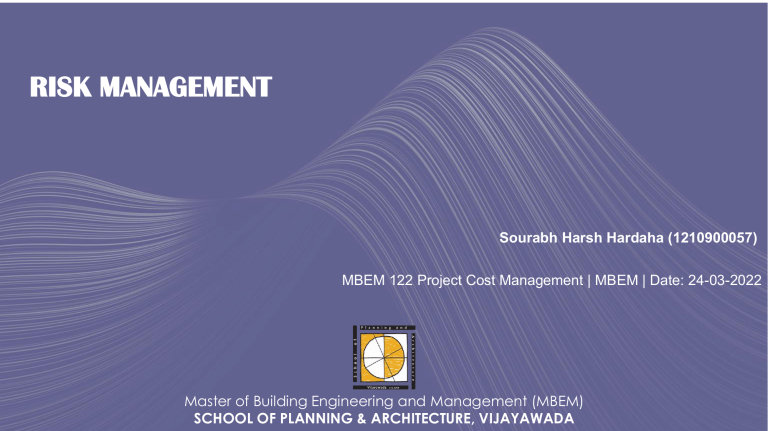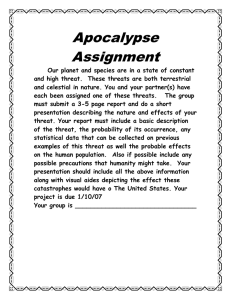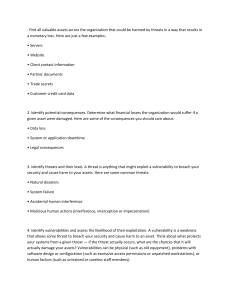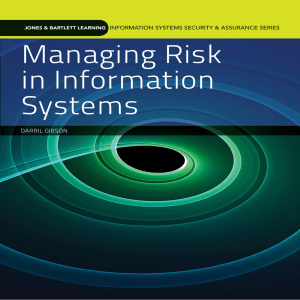
RISK MANAGEMENT Sourabh Harsh Hardaha (1210900057) MBEM 122 Project Cost Management | MBEM | Date: 24-03-2022 Master of Building Engineering and Management (MBEM) SCHOOL OF PLANNING & ARCHITECTURE, VIJAYAWADA RISK CANNOT BE ELIMINATED, BUT IT CAN BE MINIMIZED, TRANSFERRED, OR RETAINED. (BURCHETT, 1999) “The systematic approach makes the risks clear, formally describing them and making them easier to manage.” Risk Management helps to: • It makes risks explicit (by identifying, assessing, and ranking risks); • It focuses on all the major risks of the projects; • It helps in making informed decisions (mitigation measures); • It controls most of the uncertain aspects of the construction projects; • It clarifies and formalizes roles of all parties involved in the project; • It also identifies the opportunities to enhance the project performance. The Risk management improves the project being completed on time, within budget, to the required quality, and with proper provision for the safety and environmental issues. DEFINITION OF RISK The chance of an adverse event depending on circumstances is called "Risk". The risk impact can be measured as the chance of occurring a particular unwanted event and its consequence or loss. RI = L x C where; RI = risk impact L = likelihood C = consequence Risks QUANTITATIVE RISK QUALITATIVE RISK RISK ASSESSMENT IN CONSTRUCTION PROJECT Risk categories are broad, and they include the sources of risks that the organization has encountered. Some examples of categories include: External: Government related, Regulatory, environmental, market-related. Internal: Service-related, Customer Satisfaction-related, Cost-related, Quality-related. Technical: Any change in technology-related. Unforeseeable: Some risks about 9-10% can be unforeseeable Types of Risks Threats - these are negative risks. Opportunities - these are positive risks. The standard practice to identify risks is reviewing project-related documents such as lessons learned, articles, organizational process assets, etc. RISK ASSESSMENT IN CONSTRUCTION PROJECT Techniques for Gathering Information Brainstorming Brainstorming is done with a group of people who are focused on identifying project risks. The Delphi Method An anonymous panel of experts was consulted. A list of the required information is distributed to experts, their responses are compiled, and the results are distributed back to them for further review until a consensus is reached. Interviewing To identify risks, an interview is conducted with project participants, stakeholders, experts, and so on. Analysis of the Root Causes The root causes of the identified risks are identified. These underlying causes are then used to identify additional risks. Swot Analysis (Strength, Weakness, Opportunities, and Threats) The project's strengths and weaknesses are identified, and thus risks are identified. RISK ASSESSMENT IN CONSTRUCTION PROJECT Techniques for Gathering Information Analysis of Checklists The risk category checklist is used to identify additional risks for the project. Analysis of Assumptions The identification of various project assumptions and their validity aids in the identification of project risks. Outputs to Identify Risks This process of Risk Identification results in the creation of a Risk Register. Register of Risks A Risk Register is a living document that is regularly updated throughout the project's life cycle. It is incorporated into project documents and is kept in historical records for future projects. The risk register includes: • a list of risks; • a list of potential responses; • a list of root causes of risks; and • updated risk categories. RISK MANAGEMENT The risk management process is organized. Risk management efforts are not limited to developing a standardized checklist based on previous project experience. Risk management efforts should be tailored to the project's size, complexity, and skill levels. The risk management plan may include: • Methodology: The risk management process is defined; • Roles and responsibilities: Individuals involved in risk management are identified; • Budgeting: The cost of the risk management process is determined; and • Timing: The time when the risk management process should begin is determined. • Risk categories • Probability and impact definitions • Probability and impact matrix • Reporting, recording, and auditing The process of determining ways to reduce or eliminate any threats to the project, and also the opportunity to increase their impact. Risk Response Strategies: THREAT AVOID: focus on eliminating the cause (threat elimination) MITIGATE: reducing the impacts of the risk (mitigation of risks) TRANSFER: transfer the risk to some other party; Insurance purchase, warranties, guarantees, etc. OPPORTUNITIES EXPLOIT: modifying and adding work in a project to ensure that the opportunity occurs. ENHANCE: increase the positive impact of risk events SHARE: Transfer ownership of an opportunity to a third party. RISK RESPONSE THREAT AND OPPORTUNITIES ACCEPT: Passive acceptance allows the action to be determined as needed in the event of a risk event. Active acceptance may include contingency plans to be implemented if the risk occurs, as well as the allocation of time and cost reserves to the project. A decision to accept risk must be communicated to stakeholders. ESCALATE: Risks that cannot be monitored and managed by the project are escalated to a higher level, such as program management. RESPONDING TO THREATS OR OPPORTUNITIES: • Strategy implementation must be time-bound. • Strategy execution must be time-bound. • The effort chosen must be proportionate to the severity of the risk. • A single response can be the result of a series of risk events. • A strategy can be chosen not only by the project manager, but also by members of the team, stakeholders, and experts. MONITOR AND CONTROL RISKS The action involved in Risk Management • Determine the occurrences of risk triggers • Identify and monitor residual risks • Maintain risk identification, analysis, and monitoring as an iterative process in the project • Evaluate the effectiveness of the risk response plan • Risk status should be collected and communicated • Monitor the rigor of risk management procedures • Determine if additional risk responses are required recommend corrective actions WORKAROUNDS • RISK REASSESSMENTS: The process of periodically reviewing the risk management plan and risk register and adjusting the documentation as required is termed risk reassessment. • RISK AUDITS: Risk audits help the project manager prove that all the risks are identified, a plan of mitigation for each major risk is available and risk response owners are prepared to take action. • RESERVE ANALYSIS: While the work is being done, reserve analysis is simply checking to see how much reserve remains and how much might be needed. • STATUS MEETINGS: Risks should be one of the major points of discussion in every team (project status) meeting. CONCLUSION The burden of responsibility of identifying risks and dealing with them remains with parties that carry the risk. Risk management is the not-failproof way to remove all risks from the project from a construction project; its primary aim is to ensure that risk is managed most efficiently. Risk management should be viewed as a positive and creative process task. It aims to get realistic expectations and increase the control of the project






